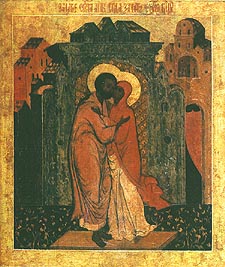Conception of the Most Holy Theotokos by Saint Anna

The Gospels and other books of the New Testament do not mention anything about Saint Anna, the mother of the Theotokos. According to Tradition, the priest Matthan (Matthew 1:15), a resident of Bethlehem, had three daughters: Mary,1 Sobe (Sobḗ), and Anna. Mary was married in Bethlehem, where she gave birth to Elizabeth, the mother of Saint John the Baptist.
The Holy Righteous Anna was the youngest daughter of the priest Matthan, who was from the tribe of Levi, of the family of Aaron. Her husband, the Holy Righteous Joachim was from the tribe of Judah, from the house and family of King David. According to the ancient promise, the Messiah was to come from the lineage of King David (Luke 2:4).
The couple lived in Nazareth of Galilee. Every year, they gave two-thirds of their income to the Temple in Jerusalem, and to the poor. By God's Providence, the holy couple had no children until their old age. They were greatly saddened by this, since the Jews considered childlessness a great misfortune and a punishment from God. They prayed fervently for the Lord to give them children.
On a certain feast, when the Israelites were bringing gifts to God in the Temple at Jerusalem, the High Priest, believing that the childless Joachim did not have God's blessing, refused to accept gifts from him. Saint Joachim was grief stricken. He consulted the genealogy of the twelve tribes of Israel and ascertained that all righteous men had offspring, including Abraham, when he was a hundred years old. Without returning home, Saint Joachim went into the wilderness and spent forty days there in strict fasting and prayer, entreating God's mercy for himself, and washing away his disgrace with bitter tears.
Saint Anna thought that she was to blame for their sorrow. One day saw a nest with barely fledged chicks in the branches of a laurel tree, she wept and prayed for the gift of a child, promising to bring the infant to God as an offering. As soon as Saint Anna spoke these words, an Angel of the Lord told her that her prayer had been answered, and revealed that she would have a daughter named Mary, through whom all the peoples of the world would be blessed. Rejoicing, Saint Anna hastened to the Temple in Jerusalem, in order to give thanks to God. She repeated her vow to dedicate the child to Him. An Angel came to Saint Joachim in the wilderness with the same news and commanded him to go to Jerusalem. There, the Righteous Anna conceived and gave birth to the Most Holy Theotokos.
The Orthodox Church does not accept the teaching that the Mother of God was exempted from the consequences of ancestral sin (death, corruption, sin, etc.) at the moment of her conception by virtue of the future merits of her Son. Only Christ was born perfectly holy and sinless, as Saint Ambrose of Milan teaches in Chapter Two of his Commentary on the Gospel of Saint Luke. The Holy Virgin was like everyone else in her mortality, and in being subject to temptation, although she committed no personal sins. She was not a deified creature removed from the rest of humanity. If this were the case, She would not have been truly human, and the nature that Christ took from her would not have been truly human either. If Christ does not truly share our human nature, then the possibility of our salvation is in doubt.
Saint Anna has been honored since ancient times. We infer this from various Fathers of the Church, and also from ancient hymns in honor of the mother of the Theotokos. In the year 550, Emperor Justinian dedicated a temple in Constantinople to Saint Anna.
Part of the Saint's left hand is located in Stavronikita Monastery on Mount Athos. Part of the Saint's incorrupt left foot is located in Saint Anna's Skete on Mount Athos. Part of the Saint's incorrupt right foot is located in the Monastery of Koutloumousiou on Mount Athos.
Fragments of the Saint's Holy Relics are to be found in Saint Anna's Monastery at Lygaria in Lamia, and also in the Monastery of Saint John the Theologian at Sourotis.
Some of the Saint's incorrupt flesh is in the Roman Catholic International Crusaders Collection of Holy Relics. The Saint's wrist is to be found in the Roman Catholic church of Saint Paul "Outside the Walls" in Rome.
Many icons of the Conception by Saint Anna show the Most Holy Theotokos trampling the serpent underfoot. Saints Joachim and Anna are usually depicted with hands folded in prayer; their eyes are also directed upward and they contemplate the Mother of God, who stands in the air with outstretched hands; under her feet is an orb encircled by a serpent (symbolizing the devil), which strives to conquer the universe by its power.”
There are also icons in which Saint Anna holds the Most Holy Virgin on her left arm as an infant. On Saint Anna’s face is a look of reverence. A large ancient icon, painted on canvas, is located in the village of Minkovetsa in the Dubensk district of Volhynia Diocese. From ancient times this Feast was especially venerated by pregnant women in Russia.
1 This Mary is the mother of Saint Anna, and the grandmother of the Theotokos. She is commemorated on the Sunday of the Forefathers.


